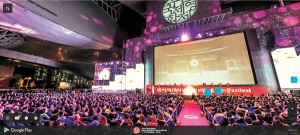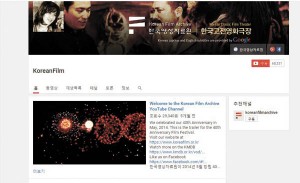If there is one thing that Google, the international tech giant, does better than anyone else, it’s providing online content.
Type any term in its various search engines, and the company’s many affiliates such as YouTube and Google Play will immediately bring forth the best information available on the Internet.
Fortunately, merely stacking up a vast amount of information in search results is not the only thing the IT company does.
For the past several years, Google has been using its special set of skills and resources to sponsor diverse cultural properties from all over the world.
And Korea has been no exception.
In 2011, Google joined hands with the Ministry of Culture, Sports and Tourism in order to make Hallyu or Korean Wave content – which extends far beyond K-pop – available to a global audience.
Since then, Korean cultural content ranging from traditional arts to classic film has been receiving support from the company.
Spreading ancient culture
Under the slogan “Korea Go Global,” the government and Google have been promoting diverse sectors of arts and culture with the help of technology.
Most representatively, the Google Cultural Institute (GCI), a global project founded in 2011 as a nonprofit affiliate, aims to make art works and exhibitions from all over the world available through its online platform.
It currently has more than 700 partners from 60 countries, and the number keeps growing.
Earlier this year, the company partnered with 10 more institutions in Korea, adding 1,500 pieces of artworks to its Internet collection.
![Google shows its support for hangul, Korea’s centuries-old alphabet system, by sponsoring a section at the National Museum of Hangeul in Seoul. [GOOGLE]](https://www.koreadailyus.com/wp-content/uploads/2015/12/05034612.jpg)
Amit Sood, the director of the Google Cultural Institute, said during his visit to Seoul in May that he wants to provide the global audience with a “quick sense” of what Korean culture is with the help of technology.
A new partnership with the Dankook University Seokjuseon Memorial Museum in Yongin, Gyeonggi, is a good example of this aim.
The museum, which opened in 1981 with donations to the university of 3,365 artifacts related to Korea’s traditional clothing, is a unique institute that offers a broad and in-depth look at how ancient Koreans dressed.
Through the partnership with Google, 150 pieces from the museum’s collection are now available to view by anyone interested in the history of Korean wardrobes.

The online exhibits are available in more than 20 languages, in line the goal of making everything “global.”

Through a partnership with the Recording Industry Association of Korea, the website also gives a sneak peek at what’s on offer in Korea’s pop music scene, as well as presenting a futuristic view of Seoul by introducing Dongdaemun Design Plaza, the latest cultural hub in the capital, designed by the world-renowned architect Zaha Hadid.
In addition to digitizing art pieces and exhibitions to their own online platform, Google also provides more practical help to museums and cultural institutes.
The company offers a special platform which enables the creation of mobile apps without special skills or a large budget, for those institutions that lack resources in that area.
And the most unlikely field of Korean culture that Google has shown support for is none other than the country’s writing system, hangul.
Acknowledging the deep pride Korea has toward hangul as well as its systematic uniqueness, Google decided to sponsor a section of the National Hangeul Museum in 2013 where foreigners can learn about the history of the writing system as well as how it works.
Equipped with experience and learning centers, the state-owned museum opened in 2014.
Introducing K-film
The Korean film sector is another field of culture that Google has taken great interest in.
In 2012, YouTube, Google’s online video platform, joined hands with the Korean Film Archive to provide 111 classic Korean films from the late 20th century to the global audience, free of charge.
All film are provided with English subtitles.
According to Google officials, users from more than 200 countries have viewed these classic Korean films on YouTube, and the monthly viewership has increased from 75,000 in 2012 to 250,000 now.
Taking its ambition to introduce Korean films to a wider audience a step further, Google Play participated as a premium sponsor of this year’s Busan International Film Festival (BIFF), which took place in the southern port city in October.
The company reproduced the festival’s grand opening ceremony with the help of dozens of panoramic photos taken at the site, allowing Internet users to virtually walk the red carpet and even look around at the star actors and directors who attended the event.
“We are demonstrating this technology for the first time at BIFF because we think as an international film festival, it should be available to global audiences as well,” explained Paul Kim, Google’s head of marketing, devices, content and retail for Asia-Pacific, at a press conference in October.
BY JIN EUN-SOO [jin.eunsoo@joongang.co.kr]


![Korea, Japan, China to push for trilateral FTA to take on Trump’s tariffs U.S. President Donald Trump speaks during the National Republican Congressional Committee dinner at the National Building Museum in Washington on April 8. [REUTERS]](https://www.koreadailyus.com/wp-content/uploads/2025/04/0409-Trump-218x150.jpg)
![Clovine accelerates global expansion in collaboration platform market Website of Clovine, a cloud-based project management provider [Screenshot]](https://www.koreadailyus.com/wp-content/uploads/2025/04/0403-clovine-218x150.jpg)



